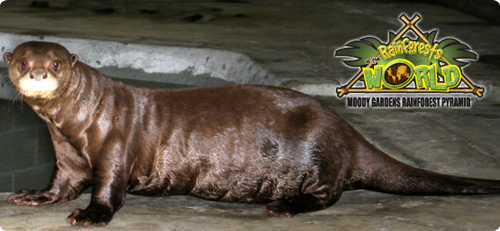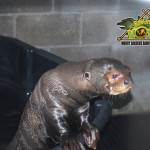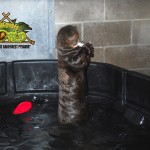Don’t call her a weasel! Come meet Zinga, our African Palm Civet who lives in the nocturnal animal exhibit at the Moody Gardens® Rainforest Pyramid®. The African Palm Civet (Nandinia binotata) is a small cat-like relative of weasels and mongooses and is one of the many mammals you’ll meet on your adventure when the Rainforest Pyramid® reopens on May 28th.
African Palm Civets are found in the forests of eastern and central Africa and are threatened due to loss of habitat. They will usually weigh between 3.7 to 4.6 pounds and are brown to light tan in color with a mottled series of darker brown spots. The fur is darker on the top half of the body to help the Civet stay camouflaged in the trees. The Civet also has bare pink pads on its feet to help provide cushioning and friction while they move and hunt. It also has a thick, muscular tail which helps with balance. These omnivores (both meat and plant eating) will use its back feet and tail to grip and balance on branches while using its front feet to grab and manipulate prey. It will then finish off its prey with a series of fast bites. If the prey is small enough, it may swallow it whole.
Civets are arboreal (tree dwelling), solitary and crepuscular, meaning only active at dawn and dusk. Females will usually give birth to up to four young after two months of gestation. Also, the female’s mammary glands secrete an orange-yellow liquid that turns the mother’s belly and the offspring’s fur orange-yellow. It is thought this is a deterrent for males wanting to mate and to protect the young from attacks. An adult male African Palm Civet may occupy a territory of over 250 acres with up to three females occupying the same territory. Each female will have her own patch of land and will only share it with their offspring. Adult male and female civets hardly socialize, but they will keep track of each other using siren-like calls.
Smell something? Civets have scent glands on their feet and tail that secrete a fruit-like smell. These scents are used for a variety of purposes.
Watch the following video to meet Zinga and come see her and her friends on May 28th at the Rainforest Pyramid®!
(Click here if the following video is not functioning)





